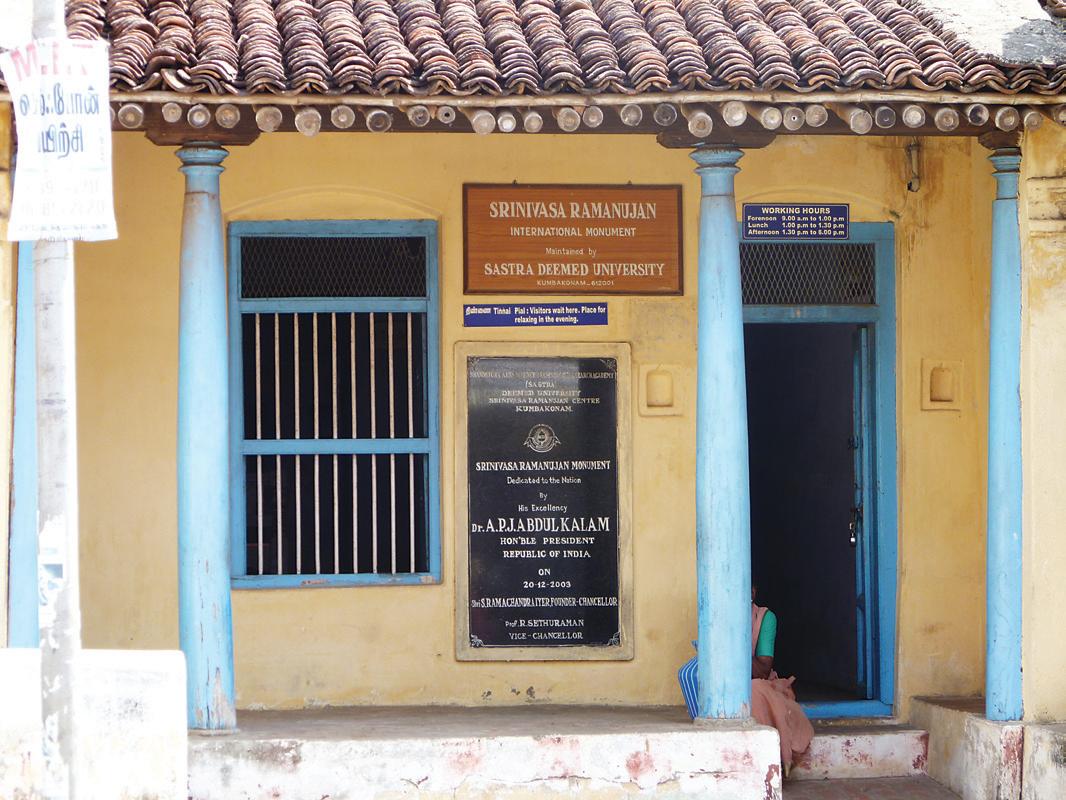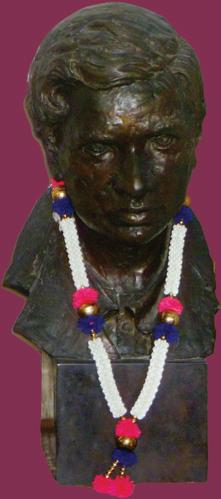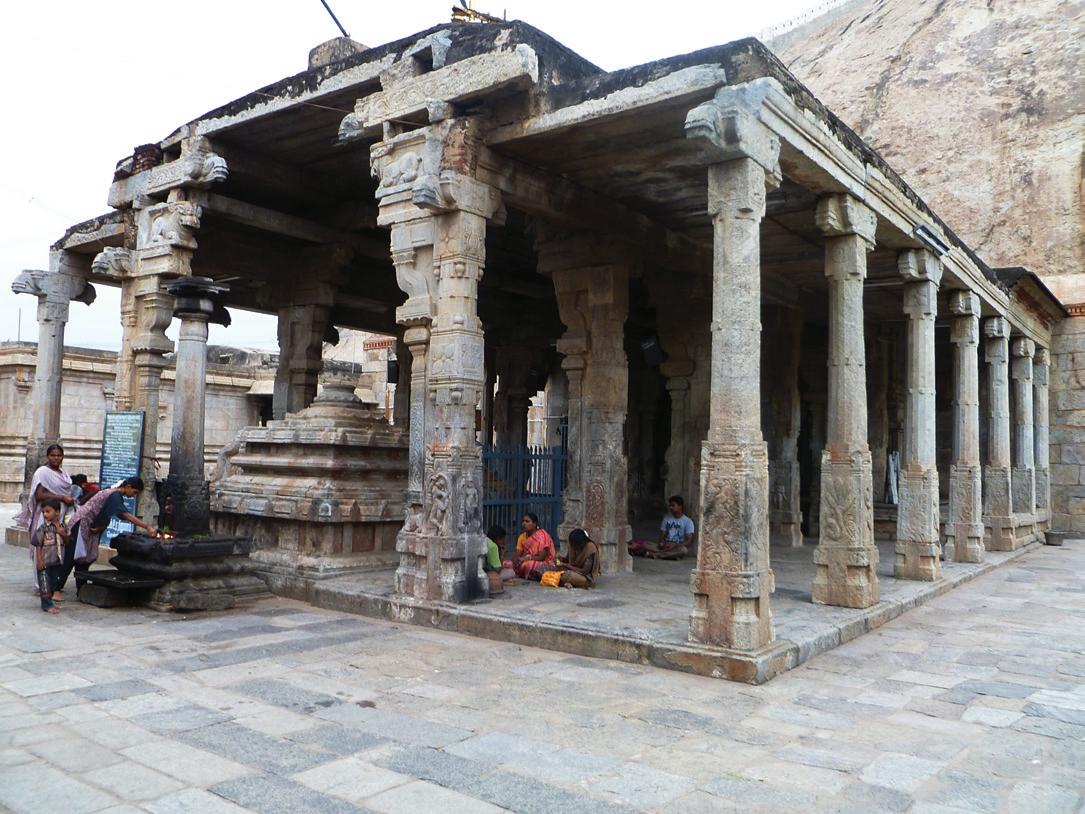
6 minute read
My mathematical pilgrimage
from 2011-07 Melbourne
by Indian Link
BY SYDNEY SRINIVAS
In the past few years, I have found myself increasingly engrossed in the life and works of Srinivasa Ramanujan (1887 – 1920), the great Indian mathematician and scholar. After a lot of research and reading, I was inclined to write about the man whose life, regrettably cut short at 32 of ill health, was the story of abject penury and that supreme gift that only he had – a truly brilliant mind.
houses a small school and the museum itself is on the first floor. The manager of the school opened the door to the museum, switched on the lights and the air conditioner, and said in that inimitable South Indian deference, “Feel free, sir.” from the museum: a copy of Kannegal’s masterpiece. I learnt that just a day before, Professor Berndt from the University of Illinois who has been following Ramanujan’s work for many years visited the museum and gave a series of talks. I wish I could leave Sydney for Chennai earlier! “Western people and the ones like you are taking so much interest in Ramanujan, but our own people show no interest whatsoever,” Meena says with a hint of regret in her voice.
Once inside the room, I was transported to a world cut off from all the noise and chaos of the sprawling metropolis outside the four walls which displayed photographs after photographs of the legend. I had seen copies of some of these in the most authoritative book on him, The man who knew infinity by Robert Kannegal, but to see the preserved original, bigger sized pictures was even more intriguing. In the centre of the room are the books he has given for the posterity, collectively called the Notebooks of Ramanujan. A large portrait of Ramanujan in colour oversees the museum. I also found photo copies of his original manuscripts there.
I was inclined to write about the man whose life, regrettably cut short at 32 of ill health, was the story of abject penury and that supreme gift that only he had – a truly brilliant mind
Meena gave me two significant contacts: first was Narayanan, the adopted son of Ramanujan’s wife Janaki, and second, Viswnathan, the grandson of Ramanujan’s mentor Narayana Ayyar.
University and later, from Cambridge. He took me inside the house and showed a bust of Ramanujan that was presented to Janaki during his centenary celebrations. There is also a colour picture of Janaki taken a few days before her death. We walked along the lane and stood at the house where Ramanujan stayed when unemployed and produced many of his famous ‘notebooks’. That place has been demolished. It’s a pity that the house where greatest breakthroughs in mathematics took place has not been preserved. The real Ramanujan, however, continues to live in the ‘notebooks.’
The formative years
I was almost compelled to experience first hand many places connected with the great man. My first destination was the Ramanujan Museum in Royapuram, Chennai. Unfortunately, my driver had a hard time taking me there as no one seemed to know of the place.
Finally, we managed to meander our way to 15/9 Soma Chetty Street, 4th lane. It’s ironical that the number that houses the memories of the most brilliant numerical mind is unheard of, particularly in the city he was so closely associated with. The street itself is unremarkable and – as we discovered after being held up for more than 15 minutes by a municipality garbage van –almost repulsively congested.
But once we were greeted by the board ‘Ramanujan Museum’, all the trouble seemed to fade away. Surprisingly, the building
I stood in front of every picture and looked at it from every angle! I was now in the company of Hardy, Neville, Littlewood, Narayana Ayyar, Seshu Ayyar and Ramachandra Rao, among others. These are the people connected with Ramanujan. The first three are from Cambridge; Hardy was the man who recognised Ramanujan’s merit which most of the Indian professors of those days could not!


There is also an imposing picture of Ramanujan’s mother Komalatammal. I shed a tear or two on seeing the many pictures of his wife Janaki who died in 1994. She was married to him at the age of 9 and lived a life of misery and hardship, which was only alleviated to some extent late in her life by the sympathy and recognition she got during Ramanujan’s centenary celebrations in 1987.

A picture of the slate Ramanujan used to perform his calculations on is in the museum.
The slate itself is preserved at the University of Illinois. The principal of a nearby school Meena Suresh has volunteered to look after the museum. She came down to the museum at my insistence and showed me around, often going into the history behind the pictures and the other memorabilia.
Trickled tales
I was surprised when Meena gave me a gift
I spent a profitable hour with Viswnathan who had many interesting stories to tell me, including how he first met Robert Kannegal: Viswnathan had arrived from London on a day Chennai was paralysed by a bandh, but he somehow managed to catch an autorickshaw. On his way he saw a westerner waiting for transport, Viswnathan asked him to hop in and only upon talking to the each other did they realise their Ramanujan connection, thus setting the foundation to a great friendship!
Viswanathan gave me a first hand account of Ramanujan’s life. His grand father had narrated to him many important events connected with the great man. One striking fact was how Ramanujan’s mother never allowed his wife Janaki to meet him, believing that it would distract him from mathematics. It was, as I learnt, Viswanathan’s grandmother who would often facilitate the meeting of the couple by calling for Janaki to help her with household chores, but asking her to use the time to meet her husband instead.
The other fact that came out was that Ayyar drafted many of the letters that Ramanujan wrote to Hardy. Viswnathan also revealed that following Ramanujan’s success in Cambridge many of the people closer to him had claimed credit for it.
This was only the first meeting and I look forward to many more such conversations with Viswanathan in future.
The next person I met was Sri Narayanan. We spoke about Janaki and Ramanujan. He revealed that she did tailoring jobs for relatives, although she did receive some financial assistance from the Madras
My next destination was Kumbakonam, the place where Ramanujan spent his pre-college days. The first morning in Kumbakonam was one of the most memorable mornings in my life. Narayanan had told me that Ramanujan’s house is the fourth to the right of the Sarangapani Temple. I was driven straight to the temple, and then I saw the house and recognised it at once as I had seen many pictures of it.
When I entered the house, the caretaker took me inside a hallway which led to a small lounge. A bust of Ramanujan greeted us. To the left was a room with a cot in it. The room’s large window stood out. It was the room where Ramanujan spent much of his childhood, often sitting by the window and talking to children passing by. We continue to find the mention of this window in writings to this day. Very few realise that this is the place where a great mathematician took shape.
We went into the temple and were drawn in by broad halls and pillars. There were not many visitors that day and I was gripped by the realisation that this is the place where Ramanujan found peace and this is where he spent his days thinking of mathematical theorems! The place for sure was heaven on earth!
After this, we proceeded to the Town High School where Ramanujan did his schooling and stood first for the entire district. A big hall here has been named after him. Our next stop was the Government Arts College where Ramanujan studied for his FA and failed in English composition which led to his discontinuation of studies altogether.
The Goddess of Namakkal Divine intervention, it is said, played an important part in Ramanujan’s life. His family believed in Goddess Namagiri of Namakkal. Ramanujan is believed to have mentioned that the Goddess came in his dreams and wrote down some of the results for his theorems. In fact, the legend goes that Nagamigiri in a dream urged him to go to Cambridge.
So, the temple of goddess Namagiri at Namakkal became my next destination. The priests at the temple showed me a big picture of Namagiri. I then saw the main idol which is said to have inspired Ramanujan and thanked the Goddess who gave us the Partition Theorem, Continued Fractions, Mock Theta Function and what not!
Thus ended my mathematical pilgrimage of Chennai, Kumbakonam and Namakkal. But, I still have to see the places in Cambridge where Ramanujan lived and worked.










